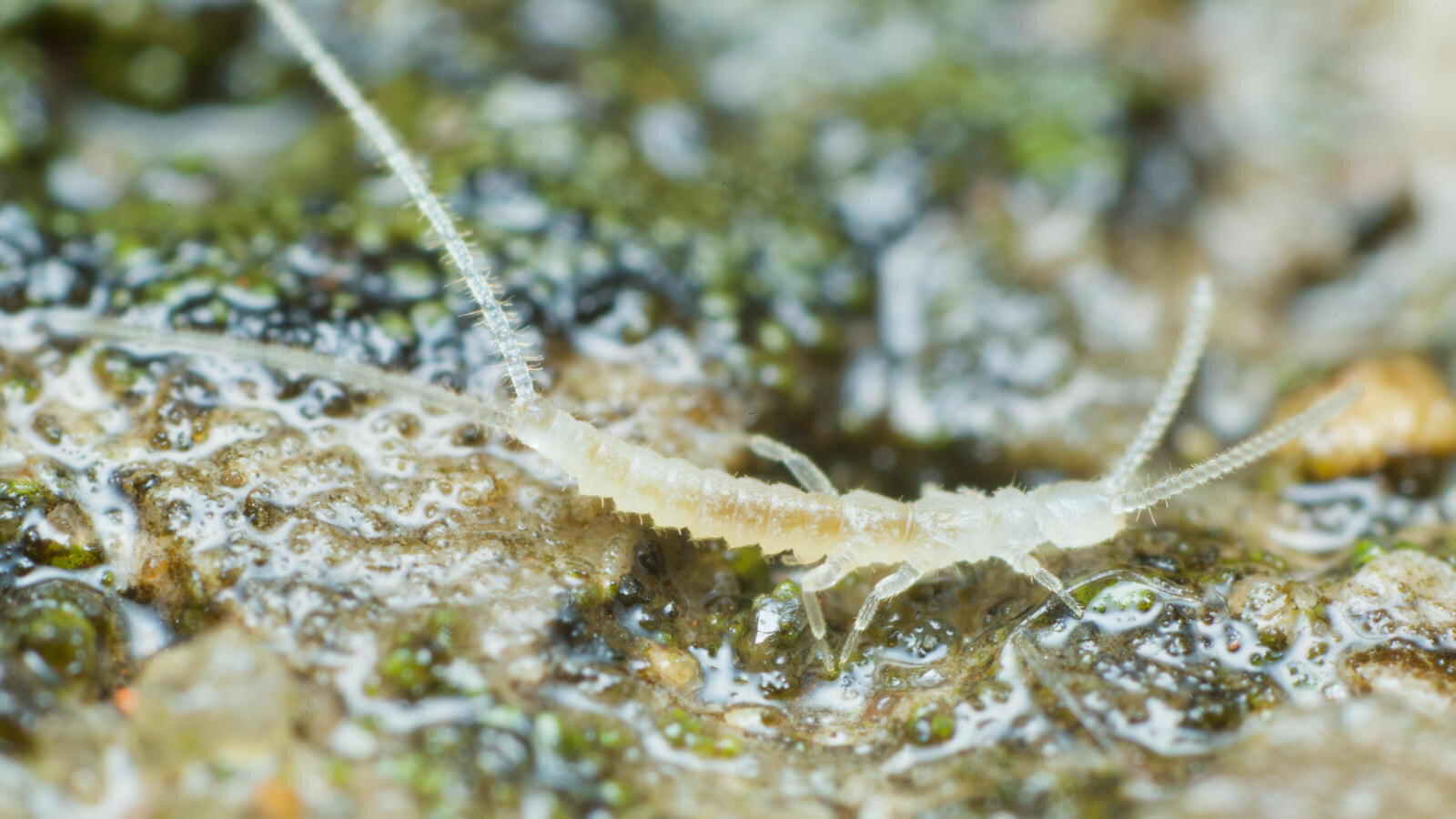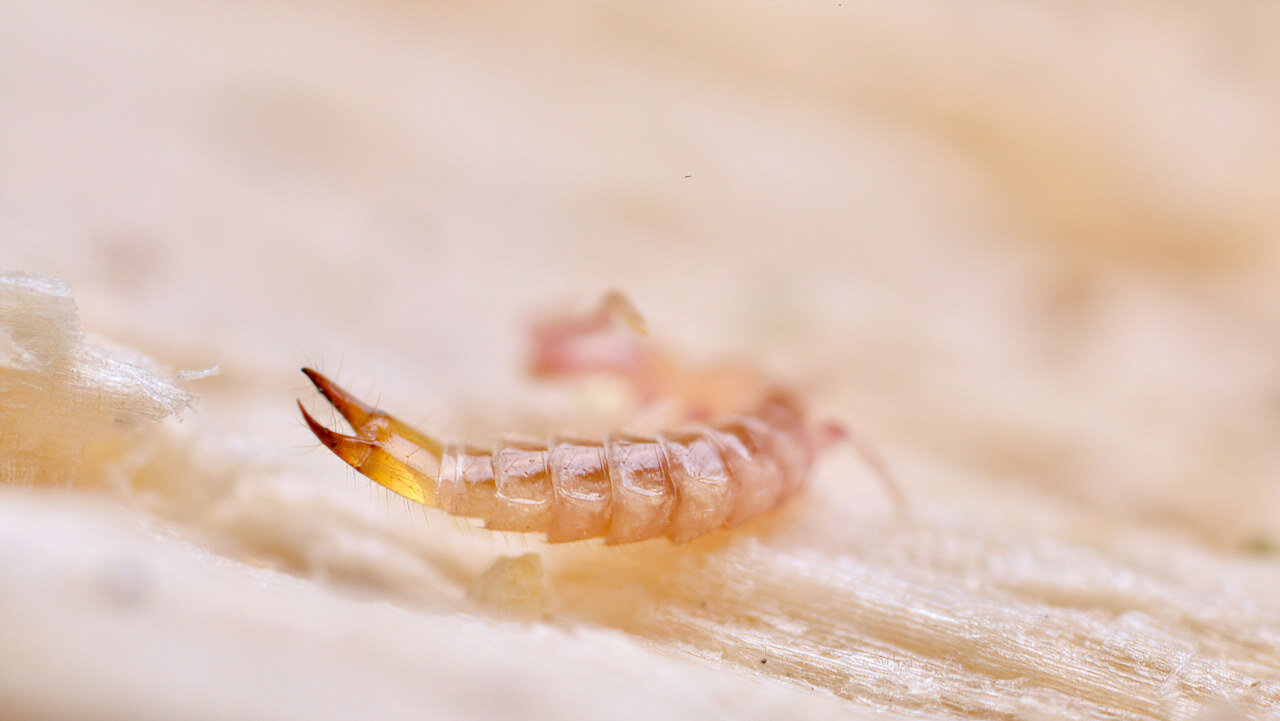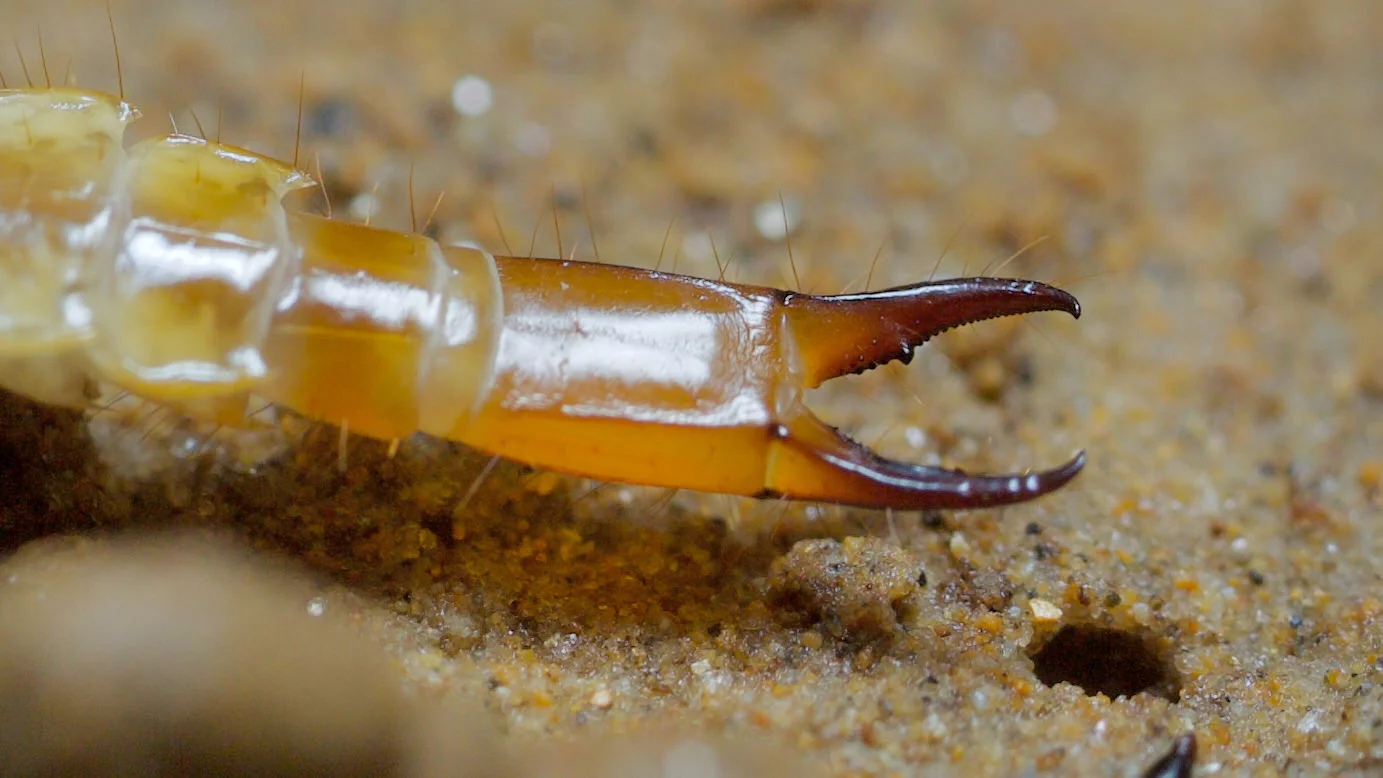
All about Diplura-
the two pronged bristletails
Diplurans are elusive and fast moving soil animals, seldom seen and when they are, can often be mistaken for symphylans or millipedes. They are small, eyeless and whitish, like most of the other soil mesofauna, with two long cerci, their tail appendages, giving them their common name. They have three lineages- the Campodeidae and the Japygidae with a rare third, the Projapygidae. These are discussed in more detail below.
Unlike insects, collembolans, proturans and diplurans continue moulting as adults, are wingless and entognathous, sharing similar retractable mouthparts, held inside a pouch. These differences were eventually considered important enough to remove all three from the Insecta class into their own- the Entognatha.
However, as mentioned on other pages, each of the three members of the almost definitely polyphyletic class of Entognatha (meaning probably not sharing a common ancestor, although having some similarities) are very unusual. Each has characteristics peculiar to itself, while sharing some others. Diplurans like the Campodeoidea are able to completely regenerate their bead-like antennae, legs and cerci, their long tail appendages, over a series of moults. This unique ability amongst the hexapods hints a little of their ancient pancrustacean ancestors. Modern crustaceans like lobsters are experts, able to start regenerating limbs within days, with moulting aiding the process.
Dipluran, Oberflockenbach, Bavaria, Southern Germany, June 2016
A second instar dipluran, Slovenia 2017
Diplura keep growing and moulting throughout their short, usually one year lives, although it's possible that some species can live around three years, like Collembola. Some can moult at least thirty times.
Both diplurans and collembolans look like miniature adults as a newly hatched instar. However, unlike Collembola, some female diplurans are known to guard their eggs and young, like pseudoscorpions.
Unlike the first instars of Collembola, which able to begin feeding upon hatching, diplurans spend their first few days immobile, as a pre-larva, similar to pre-larval mites, before moulting and beginning to feed and explore their surroundings.
Dipluran from Binna Burra, Lamington National Park, Queensland, Australia.
They are incredibly fast, and they don’t stand still very often. Below, you can see a Campodeidae at full pelt, giving some idea why most photos of diplurans are taken from above, rather than the side, as in this one. According to Colin Little in The Colonisation of Land, they can run up to 54mm/s, which works out as twenty seven body lengths per second, or 27 bl/s. A cheetah, in comparison, only travels at 16 bl/s, around 110km/h. For the cheetah to travel at the same relative speed as the dipluran, it would have to be travelling at 186 km/h.
Fast moving dipluran Somerset, Dec 2013
Campodeiodea consists of typically generalist feeders, although largely herbivorous, or detritivores. In comparison, most of Projapygoidea and the entirety of Japygoidea are predatory hunters, although still capable of detritivore behaviour.
Diplurans have articulated abdominal appendages on many of their segments, called styli, another feature they share with their order-mate, Protura as well as the order Archaeognatha, the jumping bristletails and some genera of Zygentoma- the silverfish and firebrats. Jumping bristletails, silverfish and firebrats can use their abdominal styli as extra legs in certain situations. It's been presumed that they are functionless in diplurans. This isn't correct, at least with the Campodeidae.
Usually, when traversing a flat surface, the dipluran's body is held out horizontally. But when climbing over uneven surfaces, the styli come into play, walking the abdomen over the surface. To the best of my knowledge, the photo below is the first documented evidence of this behaviour.
Side view of dipluran, showing abdominal styli in action Wetherby, W. Yorkshire UK Dec 2014
Closeup of dipluran styli
Close-up of styli on Meinertellidae family of Archaeognatha/Bristletail- Tairua, New Zealand Feb 2016
Close-up of styli on Australiatelura tasmanica, Zygentoma/silverfish NW Tasmania Jan 2016
Japygidae dipluran pincers, Mexico

Happy dipluran superfamilies
Diplurans are usually considered to have three lineages- Campodeoidea, Japygoidea and Projapygoidea. The different superfamilies can be easily separated by the three different types of cerci found across all the dipluran families. The Campodeoidea have two long, thread-like cerci on their final abdominal somite, elongated even further in some cave species like this one below, a Plusiocampa species from Slovenia.
Cave dipluran, Plusiocampa species, Divaška cave, Slovenia, April 2017
The Japygoidea have adapted, pincer-shaped cerci, as shown in the photos below. The pincers are fully functional and are used for defence and to hold down prey, with the abdomen being curled over its back and head to feed on captured prey. When hunting, it’s common for Japygids to wait, buried, with their pincered tail exposed, ready to grab any prey that gets too close.
The photo below shows Teljapyx aotearoa, a newly described cave species from the South Island of New Zealand, which is so far, the only cave-dwelling dipluran in New Zealand.
Some members of Japygoida can reach up to 60mm, but most diplurans are between 2 and 5mm.
Teljapyx aotearoa, Diplura, Council cave, Takaka hill, Nelson, NZ
Closeup of pincer-shaped cerci- Teljapyx aotearoa, Diplura
Projapygoidea are the third superfamily, and are far less studied, due to the difficulty in finding them. They have been found in South China, Tonga and Indonesia. They have a distinctively larger head in proportion to their bodies than the others, as well as shortened, cone-like-like cerci, each with a spinneret. The spinning glands produce a glandular, threadlike substance, which is sprayed with a curled abdomen at prey, to immobilise them, as if pincers or jaws weren't enough.
Recent studies have found Projapygoidea to have some genetic linking to Campodeoidea, rather than the morphological missing link between Campodeoidea and Japygoidea as was once suspected. Even so, they do share different attributes from both of the two other superfamilies.
No dipluran is able to survive beyond the polar circles, so they are absent from Antarctica, and beyond the Arctic circle in the north (66.6° N and S latitude). Their distribution is also superfamily- and latitude dependant. The Campodoidea are by far the most adaptable, being capable of surviving in tropical and sub-Arctic conditions and everything in-between, while the Japygoidea and Projapygoidea have a far more restricted and heat-dependant range.
This unknown Japygid seen below was photographed on Graham Island, Haida Gwaii, an archipelago off British Columbia, Canada. With a latitude of 53° N, this is by far the highest latitude the Japigydae have ever been observed. The highest previously recorded latitude was 49° N on Vancouver Island, British Columbia, Canada with Evalljapyx saundersi.
Japygidae, Diplura, Haida Gwaii, British Columbia, Canada

While diplurans all show adaptations to soil or cave life, being sightless and lacking pigment, some species do exhibit strong colouring, as can be seen with the yellowed dipluran below. This is due to a build-up of sub-epidermal soluble fats from their diet.



